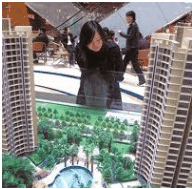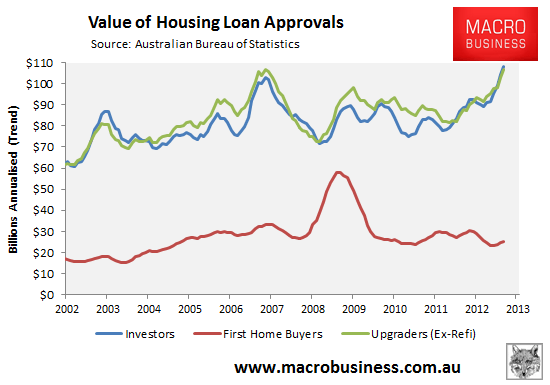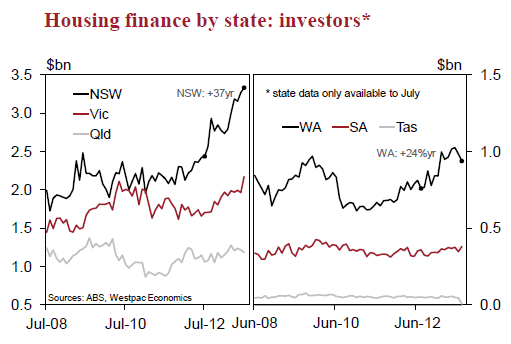
Earlier this week, property market analyst, Catherine Cashmore, posted an excellent article in Property Observer arguing that the Australian housing system is predominantly building homes for investors and in the process leaving first home buyers (FHBs) in the lurch:
Any hint that the cost of accommodation may be unaffordable for a growing percentage of potential purchasers, usually results in an accusation that first time buyers are being picky or just plain unrealistic in their expectations. Whilst low rates may assist existing owners, the short-term frenzy of activity being felt in our largest capital cities is primarily being lead by little more than confidence and speculation, with 50% of Sydney and Melbourne’s current demand is coming from the investment sector alone.
Investors now prop up valuations in the lower price bracket and consequently first-time purchasers without some kind of family assistance to help with a deposit, or dual income, often find themselves forced into a rental trap…
Housing is evidently more about investment than ownership…
The percentage of investor-owned apartments in both Darwin and Brisbane for example falls close to 70% – and in the other capitals, it comes in between 60 and 70%. In Australia, investment property contributes 32% of Australian mortgages, compared to 20% in NZ and 12% in the UK.
Local buyers leverage this debt into established dwellings with the low grade, high-density apartments being primarily sold off-the-plan to offshore purchasers which due to cultural tendencies, often results in a significant proportion sitting vacant.
…to date, the rush into apartment living has been anything but robust…
At the root of the problem lay a few issues. The relatively small one and two bedroom units featured as ‘affordable’ tend to fall into the investment sector of the market, not just because of tight lending restrictions banks impose on first home buyers for this type of accommodation, but also due to high owners’ corporation fees set aside to service the lifts and other security features.
The standard of accommodation is typically low grade and developers are pressured to pay vastly inflated commissions to achieve the pre-sale targets set out by the banking system in order to acquire funding. Hence why such projects are often aggressively marketed to offshore purchasers…
…supply shortages can still occur, even when building initiatives have been implemented…
Because of our current tax system the best-established property in our inner suburban market suited to the first home buying sector is currently a hotbed of investor demand. Therefore, as vital as it is to consider finance initiatives to stimulate new projects, it is equally important to make sure the supply constructed is diverse enough to appeal and fulfil the needs of low income owner occupiers – including an increased provision of social housing – and therefore suitably targeted toward those who need it most.
It’s hard to argue with Cashmore’s thesis. Undoubtedly, the lion’s share of domestic demand is currently being driven by investors, who are increasingly crowding-out FHBs (see next chart).

According to Westpac, investor demand seems to be concentrated in Sydney and to a lesser extent Melbourne and Perth, which partly helps to explain the recent solid price growth in these markets (see next chart).

Recent data from AFG supports this view, with investors’ share of new home loans in New South Wales increasing to nearly 50% in recent months, whereas FHB demand has tanked.
While raw data does not exist, anecdotal evidence suggests that foreign investment is also playing a major role in pushing-up prices. Last month, John McGrath, chief executive officer of McGrath Real Estate Agents, described the level of Chinese investment in Sydney as unprecedented:
“The Chinese market is extremely strong, the strongest I’ve seen a new entrant into the market”…
“I haven’t seen a trend like this in 30 years, in terms of a brand new demographic group entering the Australian market with so much impact as I’ve seen in the last 12 months”.
Harry Triguboff, founder of Australia’s biggest apartment builder, Meriton, has previously boasted that Chinese buyers comprise 50% to 70% of his company’s apartment sales, supporting claims that they are highly active in the market.
As noted earlier in the week, the solution is not to throw further subsidies at FHBs, but rather fundamental reform of the supply-side of the housing market, in addition to reducing tax incentives for property investment into pre-existing dwellings (e.g. quarantining rental losses so that they can only be offset against rental income, not unrelated wage/salary income), and tightening/enforcing rules on foreign ownership of Australian residential property.
Unfortunately, judging by recent comments from the new Federal Government, the current housing quango is something to be celebrated, and FHBs can suffer in silence.

